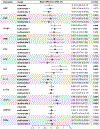Impact of HIV status on systemic inflammation during pregnancy
- PMID: 34261096
- PMCID: PMC8563396
- DOI: 10.1097/QAD.0000000000003016
Impact of HIV status on systemic inflammation during pregnancy
Abstract
Objective: There are limited studies on the association of HIV infection with systemic inflammation during pregnancy.
Design: A cohort study (N = 220) of pregnant women with HIV (N = 70) (all on antiretroviral therapy) and without HIV (N = 150) were enrolled from an antenatal clinic in Pune, India.
Methods: The following systemic inflammatory markers were measured in plasma samples using immunoassays: soluble CD163 (sCD163), soluble CD14 (sCD14), intestinal fatty acid-binding protein (I-FABP), C-reactive protein (CRP), alpha 1-acid glycoprotein (AGP), interferon-β (IFNβ), interferon-γ (IFNγ), interleukin (IL)-1β, IL-6, IL-13, IL-17A, and tumor necrosis factor α (TNFα). Generalized estimating equation (GEE) and linear regression models were used to assess the association of HIV status with each inflammatory marker during pregnancy and by trimester, respectively.
Results: Pregnant women with HIV had higher levels of markers for gut barrier dysfunction (I-FABP), monocyte activation (sCD14) and markers of systemic inflammation (IL-6 and TNFα), but surprisingly lower levels of AGP, an acute phase protein, compared with pregnant women without HIV, with some trimester-specific differences.
Conclusion: Our data show that women with HIV had higher levels of markers of gut barrier dysfunction, monocyte activation and systemic inflammation. These markers, some of which are associated with preterm birth, might help explain the increase in adverse birth outcomes in women with HIV and could suggest targets for potential interventions.
Copyright © 2021 Wolters Kluwer Health, Inc. All rights reserved.
Conflict of interest statement
Competing interests: None declared
Figures



References
-
- Brenchley J, Price D, Schacker T, Asher TE, Silvestri G, Rao S, et al. Microbial translocation is a cause of systemic immune activation in chronic HIV infection. Nat Med 2006. November 16;12:1365–1371. - PubMed
Publication types
MeSH terms
Substances
Grants and funding
LinkOut - more resources
Full Text Sources
Medical
Research Materials
Miscellaneous

